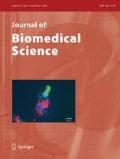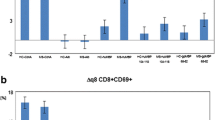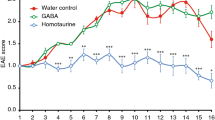Abstract
Agents which block T cell K+ currents can prohibit both proliferative and effector cell functions in T cells activated by mitogens or phorbol esters. This study examined the effects of some of these blocking agents on the immune responsiveness of guinea pig myelin basic protein (GPMBP)-reactive Lewis rat T lymphocytes, which are capable of mediating the adoptive transfer of experimental allergic encephalomyelitis (EAE), an accepted animal model for multiple sclerosis. Both the proliferative functions (DNA synthesis and cell blastogenesis) and the EAE transfer activities of GPMBP-reactive lymphocytes were examined following GPMBP-induced activation in the presence of agents shown to block the outwardly rectifying K+ current in these cells. At concentrations which completely inhibited DNA synthesis, as measured by [3H]thymidine incorporation, and cell blastogenesis, tetraethylammonium (TEA), 4-aminopyridine (4-AP) and methoxyverapamil (D600) completely blocked the subsequent adoptive transfer of EAE into naive syngeneic Lewis rats. The concentrations at which these blockers produced a 50% reduction in DNA synthesis were estimated to be 16, 1.6 and 32 µM for TEA, 4-AP and D-600, respectively, which were roughly equivalent to the EC50 to block the K+ current. Apamine, a potent Ca2+-activated K+ channel blocker, at a concentration several orders of magnitude higher than is necessary to block Ca2+-activated K+ channels, reduced the maximal K+ conductance in GPMBP-reactive T cell K+ channels by about 20%, but did not alter either [3H]thymidine incorporation or the adoptive transfer of EAE. These results indicate that delayed rectifier K+ channel blockers may prevent the activation of GPMBP-reactive T cells, thus prohibiting encephalitogenic effector cell functions.
Similar content being viewed by others
References
Ben-Nun A, Cohen IR. Experimental autoimmune encephalomyelitis (EAE) mediated by T cell lines: Process of selection of lines and characterization of the cells. J Immunol 129:303–308;1982.
Blatz AL, Magleby KL. Calcium-activated potassium channels. Trends Neurosci 10:463–467;1987.
Cahalan MD, Chandy KG, DeCoursey TE, Gupta S. A voltage-gated potassium channel in human T lymphocytes. J Physiol 385:197–237;1985.
Cahalan MD, Lewis RS. Role of potassium and chloride channels in volume regulation by T lymphocytes. Soc Gen Physiol Ser 43:281–301;1988.
Carbone AM, Ovadia H, Paterson PY. Role of macrophage-myelin basic protein interaction in the induction of experimental allergic encephalomyelitis in Lewis rats. J Immunol 131:1263–1267;1983.
Chandy KG, DeCoursey TE, Cahalan MD, McLaughlin C, Gupta S. Voltage-gated potassium channels are required for human T lymphocyte activation. J Exp Med 160:369–385;1984.
Chandy KG, DeCoursey TE, Fishbach M, Talal N, Cahalan MD, Gupta S. Altered K+ channel expression in abnormal T lymphocytes from mice with thelpr gene mutation. Science 233:1197–1200;1986.
Coronado R, Miller C. Conduction and block by organic cations in a K+-selective channel from sarcoplasmic reticulum incorporated into planar phospholipid bilayers. J Gen Physiol 79:529–547;1982.
DeCoursey TE, Chandy KG, Gupta S, Cahalan MD. Voltage-gated K+ channels in human T lymphocytes: A role in mitogenesis? Nature 307:465–468;1984.
DeCoursey TE, Chandy KG, Gupta S, Cahalan MD. Voltage-dependent ion channels in T-lymphocytes. J Neuroimmunol 10:71–95;1985.
DeCoursey TE, Chandy KG, Gupta S, Cahalan MD. Two types of potassium channels in murine T lymphocytes. J Gen Physiol 89:379–404;1987.
Deutsch C, Krause D, Lee SC. Voltage-gated potassium conductance on human T lymphocytes stimulated with phorbol ester. J Physiol 372:405–423;1986.
Dos Resi GA, Ncbrega AF, Persechini PM. Stage-specific distinctions in potassium channel blocker control of T-lymphocyte activation. Int J Immunopharmacol 10:217–226;1988.
Fukushima Y, Hagiwara S. Voltage-gated Ca++ channels in mouse myeloma cells. Proc Natl Acad Sci USA 80:2240–2242;1983.
Fukushima Y, Hagiwara S, Henkart M. Potassium current in clonal cytotoxic T lymphocytes from the mouse. J Physiol 351:645–656;1984.
Fukushima Y, Hagiwara S, Saxton RE. Variation of calcium current during the cell growth cycle in mouse hybridoma lines secreting immunoglobulins. J Physiol 355:313–321;1984.
Grinstein S, Clarke CA, Dupre A, Rothstein A. Volume increase in anion permeability in human lymphocytes. J Gen Physiol 80:801–823;1982.
Grissmer S, Hanson DC, Natoli EJ, Cahalan MD, Chandy KG. CD4-CD8− T cells from mice with collagen arthritis display aberrant expression of type 1 K+ channels. J Immunol 145:2105–2109;1990.
Hammil OP, Marty A, Neher E, Sakmann B, Sigworth FJ. Improved patch-clamp techniques for high resolution current recording from cells and cell-free membrane patches. Pflügers Arch 391:85–100;1981.
Hugues M, Romey G, Duval D, Vincent JP, Lazdunski M. Apamin as a selective blocker of the calcium-dependent potassium channels in neuroblastoma cells: Voltage clamp and biochemical characterization of the toxin receptor. Proc Natl Acad Sci USA 79:1308–1312;1982.
Jacobs ER, DeCoursey TE. Mechanism of potassium channel block in rat alveolar epithelial cells. J Pharmacol Exp Ther 255:459–472;1990.
Judge SIV, Paterson PY, Mannie MD, Yeh JZ. Modulation of outward K+ conductance is a post-activational event in rat T lymphocytes responsible for the adoptive transfer of experimental allergic encephalomyelitis. J Biomed Sci 4:98–110;1997.
Judge SIV, Yeh JZ, Mannie MD, Paterson PY. Potassium channels in T lymphocytes mediating experimental allergic encephalomyelitis (EAE) in rats. Soc Neurosci Abstr 12:1342;1986.
Judge SIV, Yeh JZ, Mannie MD, Paterson PY. Potassium channels in encephalitogenic rat lymphocytes: Characteristics of inactivation and role in cell activation. Soc Neurosci Abstr 13:531;1987.
Kohler M, Hirschberg B, Bond CT, Knizie JM, Marrion NY, Maylie J, Adelman JP. Small-conductance calcium-activated potassium channels from mammalian brain. Science 273:1709–1714;1996.
Koyasu S, Suzuki G, Asano Y, Osawa H, Diamantstein T, Yahara I. Signals for activation and proliferation of murine T lymphocyte clones. J Biol Chem 262:4689–4695;1987.
Lee SC, Price M, Prystowsky MB, Deutsch C. Volume response of quiescent and interleukin 2-stimulated T-lymphocytes to hypotonicity. Am J Physiol 254:C286-C296;1988.
Mannie MD, Dinarello CA, Paterson PY. Interleukin 1 and myelin basic protein synergistically augment adoptive transfer activity of lymphocytes mediating experimental autoimmune encephalomyelitis in Lewis rats. J Immunol 138:4229–4235;1987.
Mannie MD, Paterson PY, U'Prichard DC, Flouret G: Induction of experimental allergic encephalomyelitis in Lewis rats with purified synthetic peptides: Delineation of antigenic determinants for encephalitogenicity, in vivo activation of cellular transfer, and proliferation of lymphocytes. Proc Natl Acad Sci USA 82:5515–5519;1985.
Mannie MD, Paterson PY, U'Prichard DC, Flouret G. Encephalitogenic and proliferative responses of Lewis rat lymphocytes distinguished by position 75 and 80 substituted peptides of myelin basic protein. J Immunol 142:2608–2616;1989.
Mannie MD, Paterson PY, U'Prichard DC, Flouret G. The N- and C-terminal boundaries of myelin basic protein determinants required for encephalitogenic and proliferative responses of Lewis rat T cells. J Neuroimmunol 26:201–211;1990.
Matteson DR, Deutsch C. K channels in T lymphocytes: A patch clamp study using monoclonal antibody adhesion. Nature 307:468–471;1984.
Meuer SC, Hussey RE, Fabbi M, Fox D, Acuto T, Fitzgerald KA, Hodgdon JC, Protentis JP, Schlossman SF, Reinhery EL. An alternative pathway of T-cell activation: A functional role for the 50kd T11 sheep erythrocyte receptor protein. Cell 36:897–906;1984.
Narahashi T, Tsunoo A, Yoshii M. Characterization of two types of calcium channels in mouse neuroblastoma cells. J Physiol 383:231–249;1987.
Nel AE, Wooten MW, Galbraith RM. Molecular signaling mechanisms in T-lymphocyte activation pathways: A review and future prospects. Clin Immunol Immunopathol 44:167–186;1987.
Panitch HS. Adoptive transfer of experimental allergic encephalomyelitis with activated spleen cells: Comparison of in vitro activation by concanavalin A and myelin basic protein. Cell Immunol 56:163–171;1980.
Richert JR, Kies MW, Alvord EC Jr. Enhanced transfer of experimental allergic encephalomyelitis with Lewis rat lymph node cells. J Neuroimmunol 1:195–203;1981.
Schell SR, Nelson DJ, Fozzard HA, Fitch FW. The inhibitory effects of K+ channel-blocking agents on T lymphocyte proliferation and lymphokine production are ‘nonspecific’. J Immunol 139:3224–3230;1987.
Schlichter L, Sidel N, Hagiwara S. Potassium channels mediate killing by human natural killer cells. Proc Natl Acad Sci USA 83:451–455;1986.
Sidell N, Schlichter L. Retinoic acid blocks potassium channels in human lymphocytes. Biochem Biophys Res Commun 138:560–567;1986.
Sidell N, Schlichter LC, Wright SC, Hagiwara S, Golub SH. Potassium channels in human NK cells are involved in discrete stages of the killing process. J Immunol 137:1650–1658;1986.
Swanborg RH, Swierkosz JE, Saieg RG. Studies on the species-variability of experimental allergic encephalomyelitis in guinea pigs and rats. J Immunol 112:594–600;1974.
Wang Y-F, Jia H, Walker AM, Cukierman S. K-current mediation of prolactin-induced proliferation of malignant (Nb2) lymphocytes. J Cell Physiol 152:185–189;1992.
Weiss MJ, Daley JF, Hodgdon JC, Reinhery EL. Calcium dependency of antigen-specific (T3–Ti) and alternative (T11) pathways of human T-cell activation. Proc Natl Acad Sci USA 81:6836–6840;1984.
Author information
Authors and Affiliations
Rights and permissions
About this article
Cite this article
Judge, S.I.V., Yeh, J.Z., Mannie, M.D. et al. Potassium channel blockers inhibit adoptive transfer of experimental allergic encephalomyelitis by myelin-basic-protein-stimulated rat T lymphocytes. J Biomed Sci 4, 169–178 (1997). https://doi.org/10.1007/BF02255646
Received:
Accepted:
Issue Date:
DOI: https://doi.org/10.1007/BF02255646




